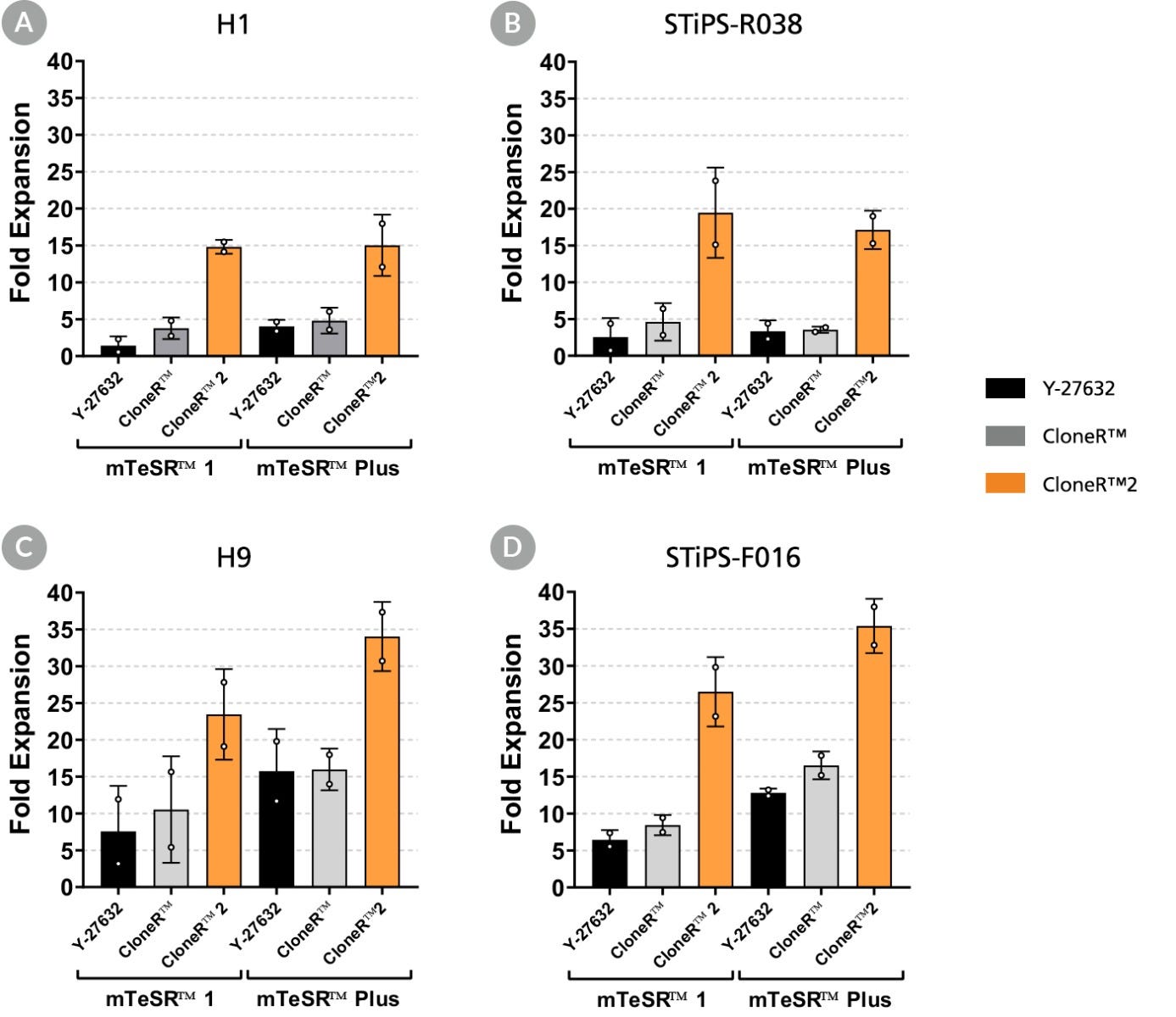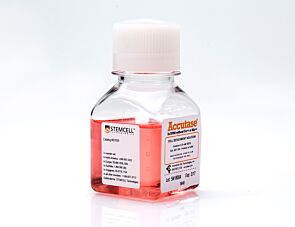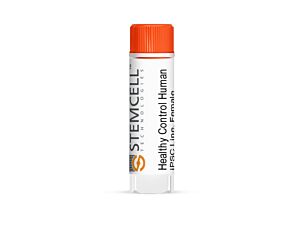CloneR™2
Defined supplement for improving survival of human ES and iPS cells in single-cell workflows
Request Pricing
Thank you for your interest in this product. Please provide us with your contact information and your local representative will contact you with a customized quote. Where appropriate, they can also assist you with a(n):
Estimated delivery time for your area
Product sample or exclusive offer
In-lab demonstration
Overview
For your gene-editing workflows, add CloneR™2 to improve ES and iPS cell survival following electroporation and during clonal deposition (see data below). It also facilitates the survival and expansion of clonal lines generated by low-density seeding (<25 cells/cm2) or by FACS-sorting cells at 1 cell/well, without requiring single-cell adaptation. You can also use CloneR™2 supplement to increase survival of single cells plated at higher densities, including under stressful conditions such as the post-thaw recovery of ES and iPS cell lines and when creating monolayers ahead of downstream differentiation.
Defined and serum-free, CloneR™2 supplement is compatible for use with TeSR™ ES and iPS cell maintenance media, as well as your choice of cell culture matrix.
Data Figures

Figure 1. CloneR™ and CloneR™2 Supplements Improve Cloning Efficiency and Colony Size
hPSCs display a considerable increase in cloning efficiency when cloned using (B) CloneR™ compared to using (A) Y-27632 compound. (C) CloneR™2 further improves cloning efficiency and increases colony size when compared to either Y-27632 compound or CloneR™. Shown are examples of H9 hESCs in 10-cm dishes, plated at 200 cells per dish (~4 cells/cm²) in mTeSR™ Plus on Vitronectin XF™.

Figure 2. Use of CloneR™2 Enables Improved Cloning Efficiency and Larger Colonies When Compared to Use of CloneR™
(A) Representative images of 200 cells (H9 cell line) in 12-well plates grown in mTeSR™1 on Vitronectin XF™ at day 8 after seeding. Three hES (H1, H7 and H9) and 5 hiPS (WLS-1C, STiPS-F016, STiPS-M001, STiPS-R038 and STiPS-B004) cell lines were seeded at clonal density (50 cells/cm²) on Vitronectin XF™, in mTeSR™1 supplemented with CloneR™ or CloneR™2. mTeSR™1 supplemented with CloneR™2 increases (B) cloning efficiency and (C) colony size of hPSCs when compared with mTeSR™1 supplemented with CloneR™. Each data point in (B) represents an average of 3 technical replicates, with at least 7 biological replicates (n) per cell line.

Figure 3. CloneR™2 Improves Clonal Generation Following Single Cell Deposition
Single-cell deposition is the gold standard of cloning; it relies on a FACS-based method that typically results in low cloning efficiency. Clones generated in mTeSR™ Plus supplemented with CloneR™2 demonstrate significantly improved (E) cloning efficiency and (B, D) colony size when compared to clones generated in mTeSR™ Plus supplemented with CloneR™. (A, C) Representative images of H9 hESCs cultured for eight days plated on Vitronectin XF™. Across four cell lines tested, CloneR™ and CloneR™2 had an average cloning efficiency of 21.2 ± 5.6% and 38.6 ± 6.0%, respectively, with at least 3 biological replicates per cell line. * denotes p < 0.05; *** denotes p < 0.001 by unpaired t-tests.

Figure 4. CloneR™2 Improves Seeding Efficiency at High Density
CloneR™2 improves single-cell seeding efficiency when used as a supplement in media for the first 24 hours of culture, compared to using Y-27632 as a supplement. 5.0x10⁵ cells were seeded in 12-well plates coated with Corning® Matrigel® in mTeSR™ Plus supplemented with CloneR™2 or Y-27632. Cultures were analyzed 24 hours post-seeding. The use of CloneR™2 resulted in an average seeding efficiency of 98.2 ± 12.8% compared to the use of Y-27632, which resulted in an average seeding efficiency of 81.9 ± 15.8%, across all cell lines (n = 3 replicates per line).

Figure 5. hPSCs Plated in CloneR™2 Show Increased Expansion
When used as a seeding supplement during single-cell passaging, CloneR™2 improves cell expansion when compared to using Y-27632. 3.0x10⁴ cells were seeded in 12-well plates coated with Corning® Matrigel® in mTeSR™ Plus supplemented with CloneR™2 or Y-27632. After 24 hours, the cultures were maintained in complete media (without a cloning supplement) and analyzed on day 5. CloneR™2 resulted in an average expansion of 49.1 ± 10.4 compared to Y-27632, which resulted in a lower average expansion of 21.1 ± 8.2, across all cell lines (n = 3 replicates per line).

Figure 6. CloneR™2 Improves Recovery of hPSCs Following Electroporation
CloneR™2 can also be used as a survival supplement in gene-editing workflows that require electroporation. Four cell lines were electroporated, then plated in mTeSR™1 and mTeSR™ Plus containing Y-27632, CloneR™, or CloneR™2. Cultures were maintained in complete TeSR™ media (without cloning supplement) after 24 hours and analyzed after 5 days. In all 4 cell lines, (panels A-D) CloneR™2 dramatically improved cell survival and expansion when used as a supplement in the first 24 hours immediately following electroporation compared to both Y-27632 and CloneR™ (n = 2 replicates per cell line).

Figure 7. CloneR™2 Improves Post-Thaw Recovery of hPSCs
Thawing cryopreserved cells can result in low expansion or loss of the culture within the first passage. Using CloneR™2 as a seeding supplement within the first 24 hours of thawing cells ameliorates this effect, improving post-thaw recovery of hPSCs. Three cell lines were frozen as single cells, then thawed into mTeSR™ Plus containing Y-27632 or CloneR™2 on Matrigel®. Cultures were maintained in complete mTeSR™ Plus (without cloning supplement) after 24 hours, and analyzed on day 4 or day 5. CloneR™2 improves the fold-expansion across all cell lines tested when compared to Y-27632, with at least 7 replicates (n) per cell line.
Protocols and Documentation
Find supporting information and directions for use in the Product Information Sheet or explore additional protocols below.
Applications
This product is designed for use in the following research area(s) as part of the highlighted workflow stage(s). Explore these workflows to learn more about the other products we offer to support each research area.
Resources and Publications
Educational Materials (12)
Related Products
-
 ACCUTASE™
ACCUTASE™Cell detachment solution
-
 mTeSR™ Plus
mTeSR™ PluscGMP, stabilized feeder-free maintenance medium for human ES and iPS cells
-
 iPSCdirect™
iPSCdirect™Single-use, maintenance-free human induced pluripotent stem cells, frozen
-
 Healthy Control Human iPSC Line, Female, SCTi...
Healthy Control Human iPSC Line, Female, SCTi...Human pluripotent stem cell line, frozen
-
 mTeSR™1
mTeSR™1cGMP, feeder-free maintenance medium for human ES and iPS cells
Item added to your cart

CloneR™2
PRODUCTS ARE FOR RESEARCH USE ONLY AND NOT INTENDED FOR HUMAN OR ANIMAL DIAGNOSTIC OR THERAPEUTIC USES UNLESS OTHERWISE STATED. FOR ADDITIONAL INFORMATION ON QUALITY AT STEMCELL, REFER TO WWW.STEMCELL.COM/COMPLIANCE.













